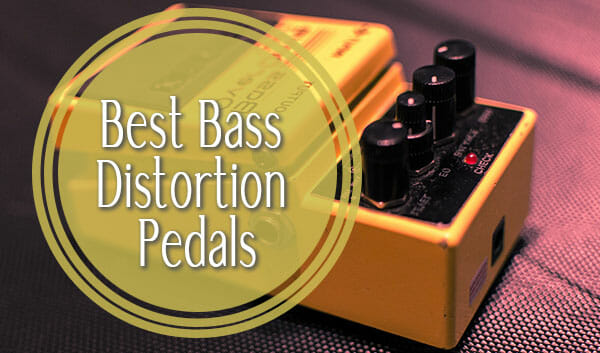
Bassists are arguably the most underrated musicians of all time. The range of skills they possess and the things they can do with a bass guitar are endless. Many bass guitarists use distortion pedals to give a distinct sound to their music. Since the dawn of heavy metal music in the 1970s and 1980s, the use of bass distortion pedals has become more and more prevalent.
In this article, we have compiled the best distortion pedals of 2025. Some might be better than others in a few aspects. Check out the list and decide which one suits your needs.
Table of Contents
- Our Top Picks
- 1. MXR M85
- 2. Boss ODB-3 Bass Overdrive
- 3. Electro-Harmonix Bass Big Muff
- 4. Way Huge WHE207 Green Rhino Mini MKIV
- 5. Tech 21 RIP Red Ripper
- 6. Electro-Harmonix Bass Soul Food
- 7. Behringer Bass Overdrive BOD 400
- 8. Pro Co Rat
- 9. Fulltone OCD
Our Top Picks
- Best budget Distortion Pedal: Behringer Bass Overdrive BOD 400
Offers so much at such a small price; the BOD 400 is comparable to pedals that cost twice as much. - Legendary Distortion Pedal: Pro Co Rat
The Rat is the most popular pedal there is. The list of artists who have used this pedal is endless. - Best Customisation: Tech 21 RIP Red Ripper
You don’t need anything else for customisation if you have six knobs and a switch. This is precisely what the Red Ripper provides. - Best for beginners: Boss ODB-3 Bass Overdrive
Not too pricey and one of the easiest to operate due to straightforward controls, ODB-3 is undeniably the best choice for beginners. - Best pedal with True Bypass: Fulltone OCD
There are not too many distortion pedals in the market that offer True Bypass feature, and Fulltone OCD is one of them. - Best sound clarity: Electro-Harmonix Bass Soul Food
Soul Food has arguably the most clear and well-balanced sounds outputs. - Most sturdy and durable: Way Huge Green Rhino
Just as the name suggests, this pedal is built like a Rhino and designed to withstand wear and tear over the years.
Best Bass Distortion Pedals: Reviews
1. MXR M85
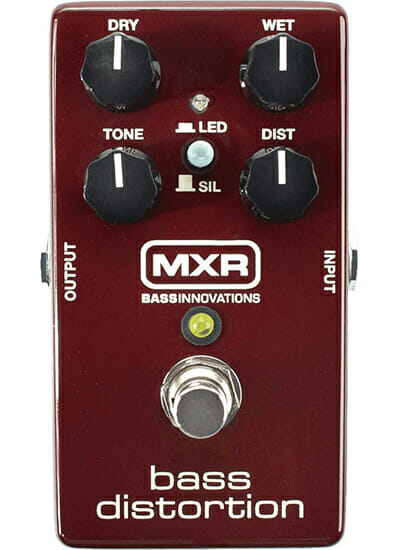
MXR is a household name in the effect pedal business. M85 is yet another product from their endless line of state of the art pedals. Although it looks a bit antique, the MXR M85 is specially designed to produce the best quality distortion exclusively for bassists.
The build, including the chassis, seems pretty stable and robust. M85 is an analog pedal which you can power using a 9 Volt battery or a DC adapter.
MXR consulted the founder of Fuzzrocious Pedal, Ryan Ratajski to design this beast of a pedal. It comes with four knobs which gives you great control over the output sound. These are wet, dry, tone and distortion. The dry knob regulates the amount of direct signal while the wet knob controls the amount of effect signal. Similarly, the tone knob affects the tone, and the distortion knob controls the level of distortion you want.
Apart from these, a LED Gain knob is also provided which sets the maximum output of the LED mode. Moreover, the M85 also gives you an option between a silicon diode or LED clipping. Both of these modes produce slightly different tones. The LED mode tones have a broader midrange than the silicon mode.
M85 is also one of the most budget-friendly distortion pedals in the market, although it might not be so straightforward to operate.
When it comes to sound quality, the MXR M85 produces raw and fluid distortions in astonishing clarity.
Pros
- Powerful and true sound.
- Budget-friendly.
- Dual-clipping means versatility.
- Multiple controls.
Cons
- Higher gain tones can be a bit sketchy.
MXR is one of the best brands in the pedal industry. They have many other brilliant distortion pedals in their product line, but we chose this for its dual-clipping feature and cost-effectiveness.
2. Boss ODB-3 Bass Overdrive
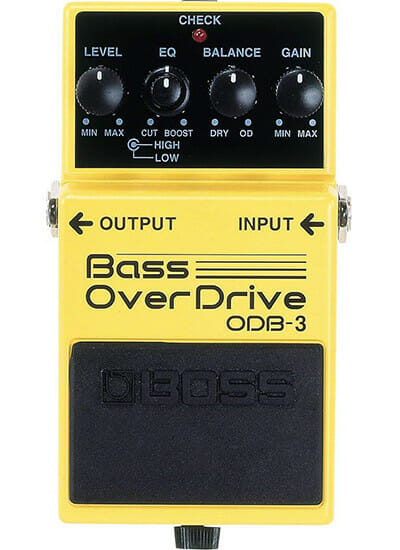
Boss is one of the oldest brands of effect pedals, and ODB-3 is one of their masterpieces. The bright yellow and black chassis gives a classic look to the ODB-3. It is essentially an overdrive pedal that produces a genuine fuzzy tone, despite the pedal being labelled as overdrive.
Boss-ODB 3 is perfect for beginners as it is pretty easy to use. It comes with four knobs, namely, Level, EQ, Balance, and Gain. The level knob is for volume, EQ is a two-band type and is used for tone shaping. The balance knob controls the amount of effect to be delivered to your signal. And finally, there is the good old gain knob, which controls the input signal.
Overall, the Boss ODB-3 delivers high-quality sounds that retain its original tone even after massive amounts of gain. The range of the sound is highly diverse; you can go from subtle overdrive to hard distortion with a few tweaks. Boss also provides you with some preset knob adjustments for knobs in the instruction manual. These presets can be extremely helpful for beginners who are still testing the waters of distortion pedals.
Pros
- Perfect for beginners.
- Budget-friendly.
- Easy to use.
- A broad range of sound due to two-band EQ.
Cons
- Knobs are a bit sensitive.
Boss ODB-3 is an all-round package that does everything. Not only is it very easy to use, which makes it great for beginners, but it also produces some of the finest distortion effects.
3. Electro-Harmonix Bass Big Muff
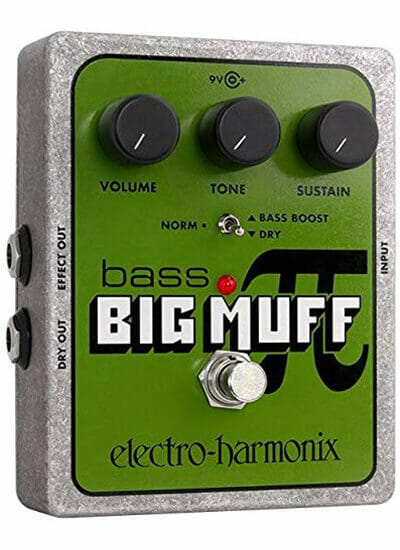
Electro-Harmonix is yet another big name in the music equipment industry. They have a reputation for making high-quality devices that are used by top performers. The Big Bass Muff is a simple yet highly sophisticated offering from Electro-Harmonix.
It comes in a full square-shaped chassis and has only three controls which make using it pretty straightforward. By the looks of it, it looks very aesthetic. Green background, metallic texture and input/output located on the side add to Big Muff’s simplicity.
But don’t let the simple looks deceive you. The three knobs which are named volume, tone and sustain, can deliver a mixed bag of sounds. Every combination has a different effect on your signal. Volume is self-explanatory, while the tone is another name for EQ knob. This knob controls the thickness of the sound. Lastly, the sustain knob controls the amount of signal you want to undergo distortion.
There is also a toggle switch in the middle which lets you choose between normal mode, dry mode or bass boost. Dry mode blends the distortion with the clean signal and bass boost gives you saturation.
EHX Big Muff is mainly preferred by artists who want a thick and meaty texture to their sound. If you are one of them, then this might be the pedal for you.
Pros
- Thick sound.
- Extra saturation with bass boost mode.
- Sustain knob is convenient and gives you total control.
Cons
- Not much customisation available when it comes to distortion.
Big Muff is another tried and tested pedal from EHX. The toggle switch in the middle is the most underrated feature of this pedal and is the primary reason why we have included it in this list.
4. Way Huge WHE207 Green Rhino Mini MKIV
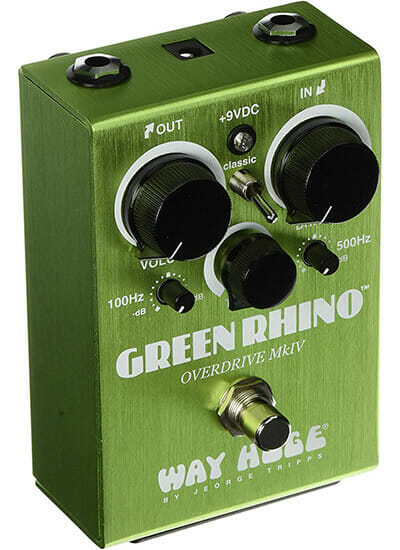
Green Rhino is one of the rarest pedals in the market. Not many people except the genuine fans of the product know about it. It is manufactured by Way Huge Electronics who despite being a smaller brand, have a lot to offer. The name Green Rhino suits this pedal perfectly. The build is sturdy like a rhino so you won’t have to worry about damage or breakage. Three inches thickness and the light green colour give it a heavy and solid feel.
It has three standard knobs, Volume, Tone and Drive, in that order from left to right. Some bassists expected a dedicated EQ knob in this pedal which they didn’t get. But you won’t miss it that much as Way Huge has done something out of the box to solve the EQ problem. They added two smaller knobs apart from the three big ones.
These two smaller knobs cut the tones at 100 Hz and 1 kHz respectively. These two, when combined, can add up or cut 6-12 dB of sound. Overall this unique combination of pedals will give you one of the rarest playing experiences. You can tweak your midrange beautifully using these two mini-knobs.
When it comes to sound quality, Green Rhino produces some of the most shattering distortions. It has a very natural sound that you can customise using its distinctive set of knobs. Also, Green Rhino is one of the most coveted pedals in the market.
Pros
- Robust build.
- Natural sound quality.
- Heavy distortion.
- More tweaking options.
Cons
- Dedicated EQ knob absent.
Way Huge Green Rhino doesn’t have a proper EQ knob but the two small knobs more than makeup for it. Those two offer a wide range of customisation to the player, especially when used with the Tone knob.
5. Tech 21 RIP Red Ripper
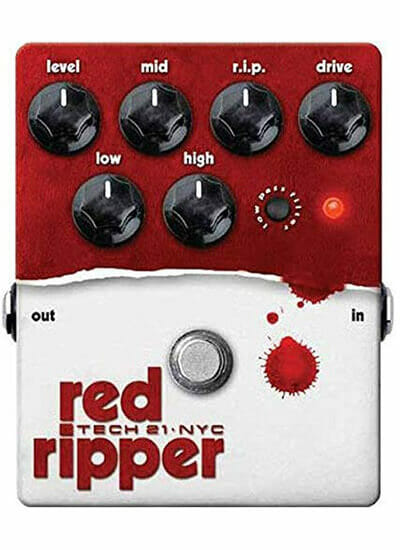
This pedal has an awesome name. And just like the name, the pedal is terrific as well. Tech 21 Red Ripper is known for some of the nastiest distortion effects possible. Those who love will go head over heels for it, but some can’t handle this pedal. Built in a reasonably simplistic red and white chassis; Red Ripper is one of the top-rated pedals.
If number of control was the criteria, then Red Ripper is the clear winner. It has an astounding six knobs and toggle switch, which offer a great deal of diversity to your tone. Low, mid and high knobs together act as a 3 band EQ. Other 2 knobs are drive and level, which are pretty standard in any distortion pedal. The exciting feature is the RIP knob, which is unique to this pedal. It allows you to choose from many types of distortion by creating an alternate harmonic sound.
The sound quality, as you can guess, is pretty amazing. The combination of so many controls gives a wide variety in your toning experience. Overall the distortion is meaty and thick.
Pros
- Highly Customisable.
- 3 band EQ.
- RIP knob gives a new dimension to your sound.
Cons
- So many knobs can be confusing for some people like newcomers.
- Expensive.
Tech 21 RIP Red Ripper had 2 reasons for its inclusion in this list. First is the sheer number of controls, and the second is the RIP knob. Both of these features make this pedal stand out from the rest.
6. Electro-Harmonix Bass Soul Food
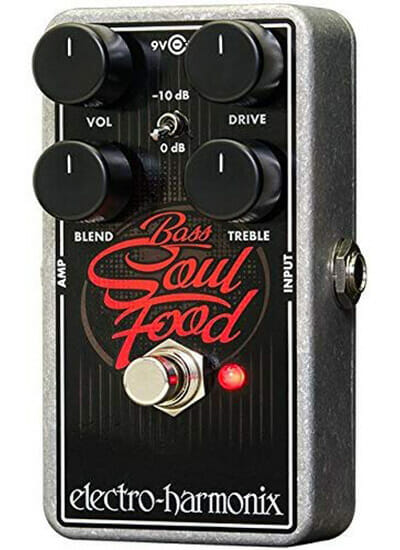
Another entry from EHX, however, Bass Soul Food is different from Big Muff in many regards. Specifically, Soul Food is known for its perfectly balanced gain and crystal clear sound. By the looks of it, the black and red design is pretty cool with subtle variations in different versions. The pedal has a standard format which makes mounting it on a pedalboard very simple.
Controls wise, there are four primary knobs and a toggle switch in the middle. The four controls are volume, drive, blend and treble. I know most of you must be wondering about the blend and the treble knob. Blend adds a beautiful colouring to your tone as it mixes the clean and distorted parts. The treble knob is very similar to the tone knob which is present in many other pedals. There is one difference though, instead of curving the frequency range, it cuts or boosts the signal. You’ll also come across a 10 dB pad in the middle, which will come in handy with high output instruments.
While playing, you’ll notice that Bass Soul Food is one of those gentler pedals. It doesn’t add heavy distortion. Instead, it produces a clear and balanced sound. If you’re not looking for too much fuzz, then this might be the right choice for you.
Pros
- Clear sound.
- Well-balanced gain.
- 10 dB toggle for high output instruments.
Cons
- Lacks dedicated EQ.
- Does not offer heavy distortion.
The sound clarity of the EHX Soul Food is unmatched in the pedal business. Currently, there is no other pedal in the market that offers such clear sounds with balanced gain.
7. Behringer Bass Overdrive BOD 400
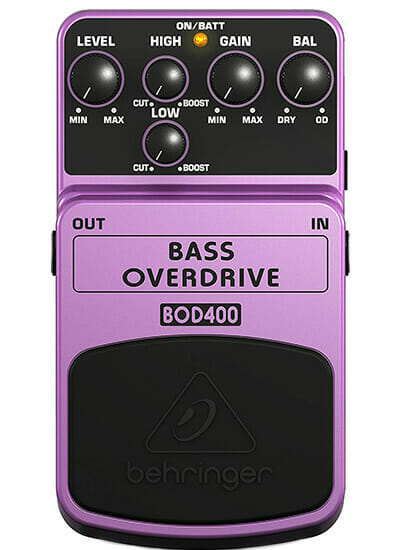
This is arguably the most unexpected entry in this list. Behringer Bass Overdrive is a budget option, so you can assume it won’t have many features. That being said, the pedal packs enormous gain and is a terrific choice if you are on a tight budget. Given the low price, the company has designed this product to compete with other high-end market offerings. The chassis is made of plastic, which can be off-putting for some people and the pedal is not among the best looking ones.
Talking about the controls, it has the usual level and gain knobs. The impressive fact is that Behringer offers 2 band EQ at such a low price. Another cool fact is the balance knob, which is kind of like the blend knob of EHX Soul Food. Beginners prefer this pedal because of its low price and an impressive set of controls.
Performance-wise, the BOD 400 is pretty neat. It is designed to do a job and that it does. You can expect heavy distortion as you increase gain after a certain threshold. It might not be one of the best looking pedals, but it certainly has one of the most excellent sounds. Behringer believes in delivering value to its customers at a low price, and it does that perfectly.
Pros
- Budget-friendly.
- Terrific sound quality.
- 2-band EQ.
Cons
- Plastic chassis can be vulnerable to damage.
Behringer Bass Overdrive BOD 400 is the best budget pedal, period. There is no competition in this regard. For those who don’t care about aesthetics, this is the perfect pedal.
8. Pro Co Rat

Pro Co Rat is one of the classic pedals and one of the simplest. It comes in an all black chassis which looks breathtaking. It is one of the oldest pedals around and was the choice of many legendary artists. Rat is unlike any other pedal in this list in every aspect. Many new-age bassists shy away from using this pedal. However, they are dwarfed by the number of Rat enthusiasts out there. Pro Co Rat is a legend among bassists, and it deserves that title.
It has 3 controls, distortion, filter and volume. Distortion knob controls the gain or clipping amount. You’ll experience more distortion as you increase it. The distinctive feature is the filter knob which removes unpleasant high frequencies. You can get some of the most brilliant sounds by tweaking the filter knob.
The sound quality of Pro Co Rat doesn’t need any explanation. As we said, it is a legend, and the sound produced is legendary as well. The pedal is one of the most versatile pedals around, as it can be used for several genres, from blues to heavy metal. If you are a player who knows his stuff and would like an upgrade on his current pedal, then this should be your first choice.
Pros
- Brilliant sound.
- Extremely versatile.
- Filter knob.
Cons
- Not suitable for beginners.
No list of distortion pedals would be complete without Pro Co Rat. It is one of the most trusted pedals in the industry and was a personal favourite of many great artists.
9. Fulltone OCD
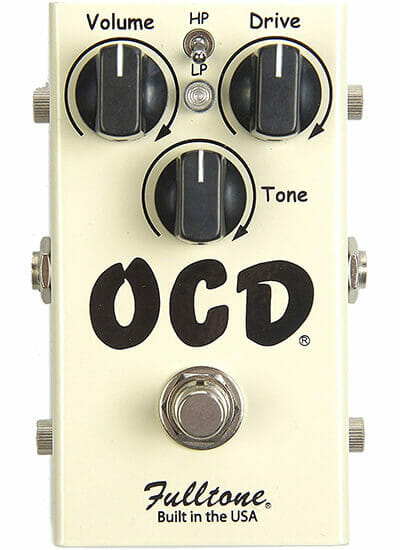
This is again one of the lesser-known pedals in the market. However, what it lacks in popularity, it makes up in performance. Fulltone OCD is known for producing one of the meanest distortion effects among all pedals. This pedal is relatively newer to the other entries of this list. Aesthetically, it is very pleasing on the eye with its creamy colour and black knobs.
Fulltone OCD has three control options, Volume, Tone and Drive. By now you must be familiar with all of these. An exceptional characteristic of OCD is that it offers a choice between True Bypass and an Enhanced Bypass filter. The type of bypass determines how the pedal behaves in bypass or disabled mode. Moreover, the company has also provided a High Peak/Low Peak switch, which can either fatten or reduce interference in your sound.
This pedal can hardly do anything wrong. The output is of excellent quality as expected and pretty varied. The switch offers a great deal of customisation which you can use to your maximum benefit.
Pros
- Pleasing on the eye.
- HP/LP switch is a massive bonus.
- Crisp sound quality.
Cons
- Lacks a dedicated EQ control.
Fulltone OCD is one of the best looking pedals in the market. Not only that, the unique HP/LP switch sets this pedal a class apart.
Difference Between Distortion & Overdrive Pedal
Distortion Pedal
Many bassists use distortion pedals to give a buzzy or distorted tone to their sound. In distortion pedals, you’ll feel nearly the same amount of distortion as the volume changes. This is not the case in overdrive pedals. Distortion pedals are mostly used by musicians who play metal music.
Overdrive Pedal
Overdrive is a milder version of distortion. Here, the distortion level fluctuates with the change in volume levels. You won’t notice much difference in your tone if you play softly, but as you’ll play harder, you’ll see that there is much harsher distortion. Many classic rock and blues are frequent users of overdrive pedals.
Best Brands: Distortion Pedals
1. Boss
Boss is one of the most notable names in the music electronics industry. They are a subsidiary of the Japanese multinational company Roland Corporation. Roland is the goliath of the music electronics industry and Boss is their division that takes care of pedals and similar devices.
2. MXR
Based out of New York, MXR is a company that specialises in making effect pedals. Their product line includes a broad range of high-quality effect pedals for guitars and bass guitars. From distortion pedals to compressor pedals, they make everything. MXR is also in the business of manufacturing musical electronic racks and drum machines. Jim Dunlop bought the MXR brand in 1987 and taken the brand to new heights.
3. Electro-Harmonix
EHX or Electro-Harmonix is an American firm that was founded by Mike Mathews in 1968. Since then, they have made a name for themselves in the music electronics industry. Mainly they are known for making high-end vacuum tubes and effect pedals. EHX was the first company to manufacture affordable stompbox and first tube-amp distortion simulator.
4. Pro Co
Pro Co is one of the well-known firms, especially due to their pedal The Rat. This pedal has its own fan following. Based out of the USA, Pro Co Sounds is an expert in making some of the most excellent musical equipment. Their list of offerings is endless, and among them, there are some truly exceptional products like the Rat pedal.
5. Behringer
Behringer is one of the largest audio machinery companies in the world. They are based in Germany and are a subsidiary of another firm called Music Tribe. Their presence is felt in every corner of the earth. Their products are not always of the highest quality, but they do the job they were designed to do.
FAQs About Distortion Pedals
Which is the best distortion pedal for metal music?
Metal music is all about distortion, whichever subgenre you pick, distortion is a critical element. So you should choose a pedal that offers maximum distortion but also maintains clarity. Green Rhino by Way Huge provides some of the heaviest distortions that you can get. Even on high gain, Green Rhino can keep bright and heavy distortion.
Which is the most budget-friendly bass distortion pedal?
Behringer Bass Overdrive BOD 400 is arguably the best cost-effective bass distortion pedal out there. The plastic build will drive some of the rich folks away, but it is an excellent option if you are on a low budget. Another cheap option is the Boss ODB-3, but you’ll have to increase your budget for this slightly.
What is the difference between a compressor pedal and a distortion pedal?
There are a lot of types of pedal available, compressor and distortion are just two of them. The primary difference between the two is that a compression pedal reduces the dynamic range of the input signal. Distortion pedals, on the other hand, saturate the signal and give it a new outlook.
What is the average cost of a right bass distortion pedal?
There is a wide variety of distortion pedals in the market, with pricing ranging from modest to extreme. You can get a good bass pedal below 100 dollars if you go for some of the cheaper models. Or you can go for a used version of a high-end model, which will also come at a similar price.
Should I choose a pedal with maximum controls?
If you are a seasoned bass player who knows his way around musical instruments, then sure, yes, go for it. However, if you are still new at this, and not sure about getting the best out of some knobs, then it is best to choose a more simplistic option.
Conclusion
Distortion pedals have been in the territory of guitarists for the most part. It was not until recently; their use has become almost routine. Now there are numerous pedals in the market, each with a unique advantage that sets it apart from the rest. What suits you is something that only you can decide. We have listed all the facts; now the decision is yours.

